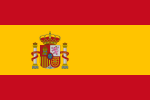Spanish Navy
The Spanish Navy or officially, the Armada, is the maritime branch of the Spanish Armed Forces and one of the oldest active naval forces in the world. The Spanish Navy was responsible for a number of major historic achievements in navigation, the most famous being the discovery of America and the first global circumnavigation by Elcano. For several centuries, it played a crucial logistical role in the expansion and consolidation of the Spanish Empire, and defended a vast trade network across the Atlantic Ocean between the Americas and Europe, and the Manila Galleon across the Pacific Ocean between the Philippines and the Americas.
Spanish Navy
15th century
Our Lady of Mount Carmel (Spanish: Nuestra Señora del Carmen)
Himno de la Escuela Naval (José María Pemán)
16 July
![]() Admiral Carlos Martínez-Merello y Díaz de Miranda (acting)
Admiral Carlos Martínez-Merello y Díaz de Miranda (acting)
McDonnell Douglas EAV-8B Harrier II+
McDonnell Douglas EAV-8B Harrier II+
Sikorsky SH-60B Seahawk
Sikorsky SH-60F Seahawk
Agusta Bell AB-212+
Airbus H135
Boeing Institu ScanEagle
McDonnell Douglas TAV-8B Harrier II
Cessna Citation
The Spanish Navy was (after the Portuguese Navy) the second most powerful maritime force in the world from the late 15th century to the late 16th century and the most powerful from then on to the mid 17th century. In the early 19th century, with the loss of most of its empire, Spain transitioned to a smaller fleet but maintained a major shipbuilding industry which produced important technical innovations. The Spanish Navy built and operated the first military submarines, made important contributions in the development of destroyer warships, and again achieved a first global circumnavigation, this time by an ironclad vessel.
The main bases of the Spanish Navy are at Rota, Ferrol, San Fernando and Cartagena.
The Spanish Navy shares the organization model of its two sister services – the Spanish Army and the Spanish Air and Space Force. Each of them consists of a Headquarters (Cuartel general), a Force (Fuerza, composed of the operational units) and a Force Support (Apoyo a la fuerza, composed of administration, logistical and training units). For historical traditions the Force of the Spanish Navy is called Fleet (Flota) and the two terms are used interchangeably. At the head of the Navy is an Almirante general (a four-star rank reserved for the Chief of the Spanish Navy and the Chief of the Spanish Armed Forces, when the latter position is held by a naval officer), denominated AJEMA or Admiral Chief of the General Staff of the Navy (Almirante Jefe de Estado Mayor de la Armada). Counterintuitive to this official designation he holds authority over all three components of the service and the officer, who actually functions as Chief of Staff is a three-star Almirante, designated Admiral Deputy Chief of the General Staff of the Navy (Almirante Segundo Jefe del Estado Mayor de la Armada or 2º AJEMA)
Admiral Chief of the General Staff of the Navy (AJEMA) ![]()
![]()
![]()
![]()
Most of the few retired Spanish Navy ships preserved as museum ships are submarines:

